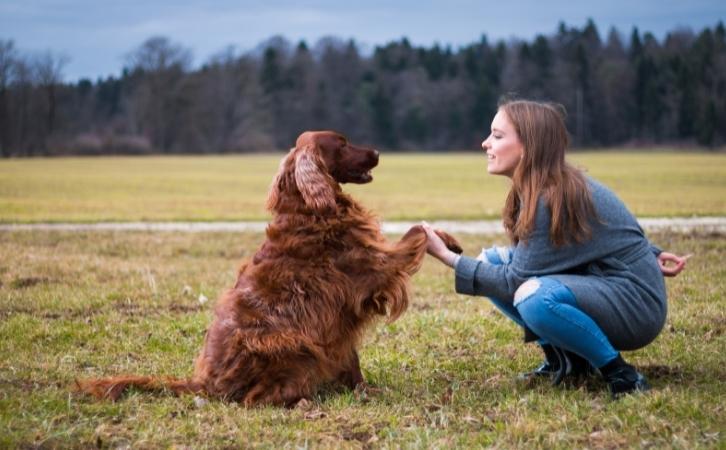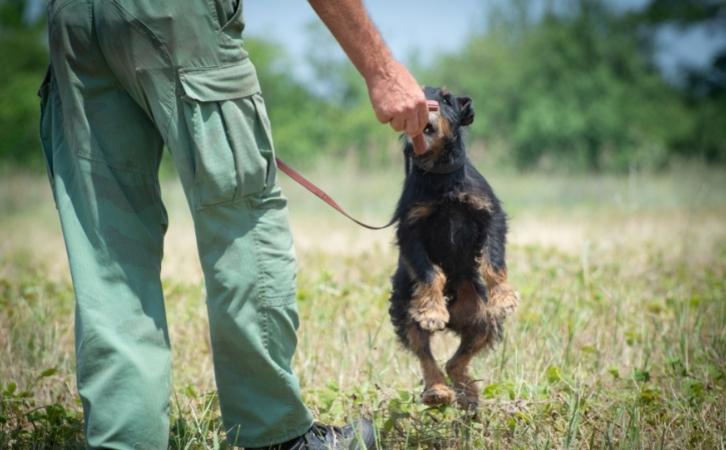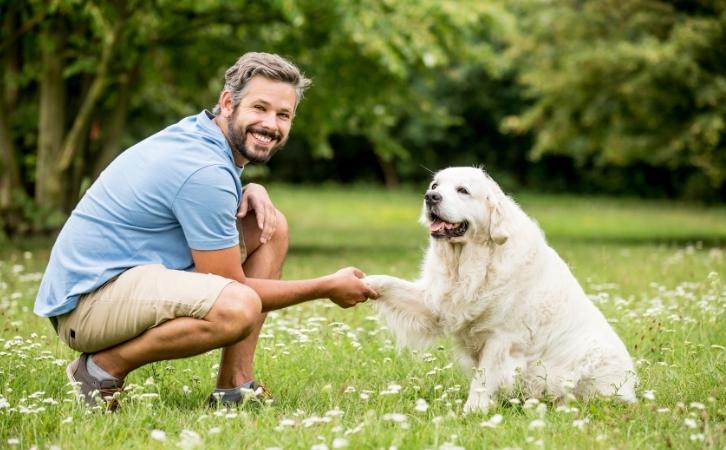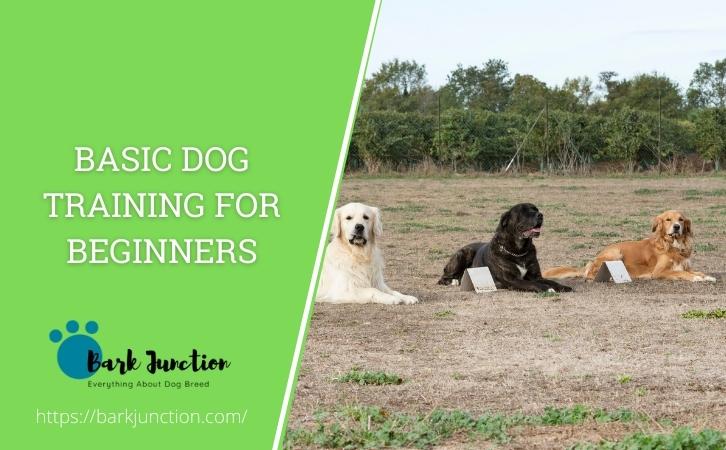Are you prepared to teach your puppy or dog? Your dog’s basic needs include proper training and socialising. It’s critical to train your dog to sit, stay, come, and go potty outside. Having a well-behaved dog makes him more secure.
If you let yours off-leash or if he moves from the home when the door is opened, he must return when called. Training strengthens your bond with your dog over time. You will get along a lot better after you understand how to speak with one another. This article will talk about some basic dog training for beginners and things to keep in mind during training sessions.
Read Here: How To Choose The Right Dog Breed For You
Table of Contents
What Is the Best Way to Teach Your Dog?
A dog can be trained using one of two approaches.
The aversive-based approach is the first. The reward-based approach is the second. When you employ positive punishment and negative reinforcement approaches with your dog, this is referred to as aversive-based (discipline) training. Only the behaviors you want your dog to follow are rewarded in reward-based systems.
To encourage your dog to behave the way you want, aversive-based training employs methods such as loud, unpleasant noises, physical punishments, and severe scoldings. On the other hand, reward-based training gives your dog a treat anytime it does what you desire. To reinforce that behavior was cheerful, treats, belly rubs, and other dog-pleasing actions are used.
Some individuals believe that using a rewards-based training strategy creates an “event sequence” where your dog associates you with good sensations when they follow your commands. Aversive approaches, on the other hand, make them fear you. Because of this dread, your dog will obey your commands to prevent bad feelings.
Read Here: What You Need to Know About Pet First Aid
Some Basic Command Training
At the early stage, every puppy needs to learn some basic commands. These commands will help the puppy and dog owners. Let us see some basic commands you must teach your puppy.
How to Teach Your Dog to Come
Consider starting with the ‘come’ command rather than the sit command, as many owners do. Teaching your pet to come to you is one of the most useful commands for keeping your best buddy safe—and one of the simplest to learn.

Simply catch your dog in approaching you and praise them while saying, “come.” You may also practise this command in your backyard or another outdoor place with a dog training lead.
Read Here: How to Choose the Right Toys for Your Dog?
Sit Training for Your Dog
It’s time to teach your dog how to sit after mastering the ‘come’ command. After all, this command is required for many others, and it’s particularly effective at imparting excellent manners. An attentive dog that sits on demand, for example, will not leap on visitors!

Simply place a dog goodie at your dog’s nose and slowly lift it above their head to teach them to sit. Most dogs follow the treat with their eyes and nose, immediately moving into the sitting position, responding to this action. Say the phrase “sit” and praise your dog with the goodie as soon as your dog begins to sit. Repeat this exercise several times to help reinforce the concept.
Read Here: Can dogs eat jaggery?
How to Make Your Dog Lay Down
Your dog is ready to lie down once they have learned to sit. Rather than pass the treat over them, slowly lower it in front of them. Your dog will reach for the treat by lowering their body. Say “down” and give your dog the treat as soon as they are in the down posture. Because single syllables are easier for dogs to learn, avoid using the longer phrase “lay down.”
How to Teach Your Dog to Stay
A dog can learn to stay after learning to sit and lie down. The stay command, like down, is particularly useful for calming an excited dog. Begin by putting your dog in a sitting position to teach them this command. Then, with your hand outward, signal them to come to a halt. Repeat the command “stay” as long as your dog remains still. After a few seconds, approach them and reward them for their cooperation with a treat. Increase the amount of time you wait before giving them the prize gradually.
Toilet Practice Training
Toilet training is a must if your dog spends any time indoors. For everyone concerned, toilet training is typically a time of hardship and worry. But if you’re patient and employ the right training tactics, you’ll get a positive result.

Begin when the dog is still young, around 3 to 4 months old. Any early, and your puppy will most likely lack adequate bowel and urine control. The training period will almost certainly be substantially longer if you begin later.
Begin the training by limiting the puppy to a small space, such as a single room, the length of a tethered line, or even a crate. You can progressively widen the area where your puppy is allowed to explore as it learns that ‘business’ is done outside.
Read Here: What You Need to Know About Pet First Aid
7 Things To Note Down For Dog Basic Training

Before you begin the training, you must assure a few things. Applying the wrong tactics will lead to the worst situation. Here are7 Things To Note Down For Dog Basic Training.
1. Sign up for obedience classes.
Training takes time and work, and the more time and effort you put into it, the better results you’ll see. If this is your first dog—or even if it isn’t—you might wish to hire a personal trainer or enrol in a training class.
Puppy kindergarten is where puppies typically start. You can then enrol in an older puppy obedience class. The number of dog-and-handler pairings in each puppy class should be limited to eight to ten. This ratio allows the instructor to provide sufficient time and attention to each team to respond to questions or unusual training situations.
2. Use Positivity
If you make it enjoyable for your dog, he will respond to your commands. Your dog will have no idea why you are upset with him. Positive reinforcement shows your dog that you appreciate his efforts, and he will repeat the behaviour in the future.
Food, toys, or petting can all be rewards, depending on how your dog responds. Reward him with food, toys, or petting only some of the time after he has it (but verbally praise him every time). In this approach, he’ll work hard to please you in the hopes of being rewarded.
3. Keep training sessions to a minimum.
After your dog has had a chance to settle into the household for a few days, start teaching good manners. Shorten your training sessions to roughly 10 to 15 minutes each. The session can be repeated later, but each one should be brief. Plan to train your dog numerous times a day because no puppy learns to perform flawlessly in one sitting.
4. Use Small Treats
Giving him small goodies as a reward for training is a brilliant idea. Give them something to eat so that they can immediately consume it. Hard, crunchy snacks should be avoided because they take a long time to chew.
Give your dog goodies as soon as he completes the targeted behaviour—within half a second. The quicker you confirm the desired action, the easier it will be for your puppy to comprehend what you’re attempting to teach him. “Good work!” you should say once you’ve given the reward. Do not fall into giving sweets during a training session simply because your dog is cute.
5. Choose a training time.
Before your dog’s regular meal, schedule your training session. He’ll be more likely to heed the instructions and earn a delectable bite. While pups have short attention spans and may only be able to focus on training for five minutes at a time, adult dogs may be able to concentrate for 15 to 20 minutes before losing interest.
Between training sessions, a little playtime or exercise with your dog is a terrific way to keep them engaged and reward them for their hard work. Every day, and perhaps numerous times during the day, you can instruct your dog. Multiple, brief daily training sessions are likely to yield the best outcomes.
6. Never train a puppy who isn’t in the mood.
When your puppy is hot, weary, or in the middle of a vigorous play session, you should not train him. You want him to be focused and enthusiastic about the training session. So, it’s better to ignore such situations.
7. Be Patient With Your Puppy
Don’t become angry with your puppy if you’re having trouble training him. Simply end the session discreetly and try again later that day. Many dogs become afraid and stop paying attention to their trainers if they are yelled at. They may develop a fear of training and conclude that following instructions is not for them. Maintain a calm and relaxed demeanour so that your puppy can learn in a pleasant setting.
How to Socialize Puppies and Dogs
Socialised dogs are less likely to develop behavioural issues and are more widely accepted. Socialisation can also aid in the prevention of phobias and fears. In the end, socialising your dog or puppy will result in a happier, better-behaved canine.
Dog Training 101: How to Train ANY DOG the Basics
reference
Basic Dog Training for Beginners


